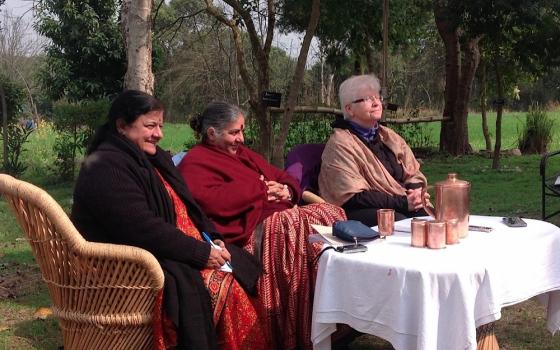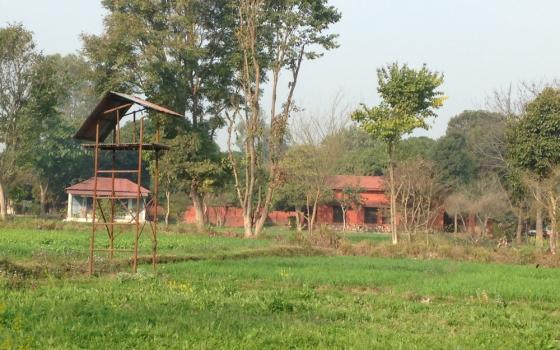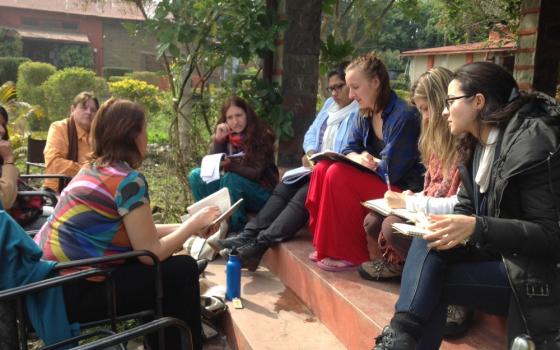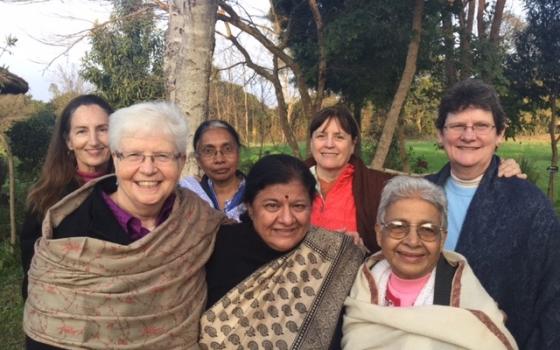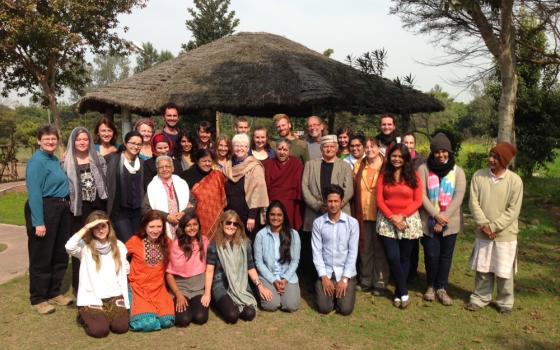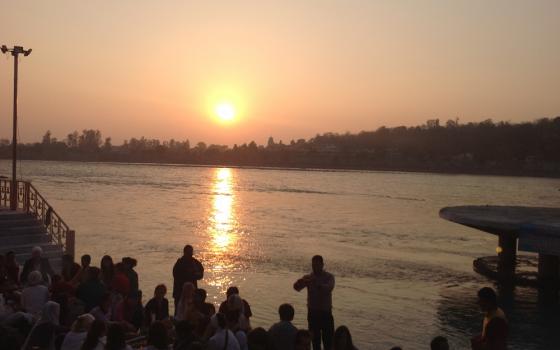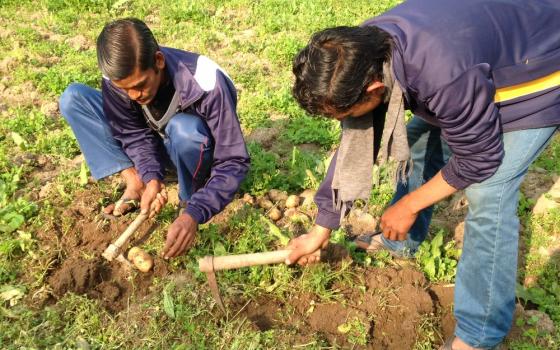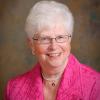Last month I returned from my first visit to India. I was invited to lead a week's workshop on “Earth Democracy: Defending the Rights of People and Mother Earth” with Dr. Vandana Shiva and her sister Dr. Mira Shiva, a physician and leader in public health. The course took place at the Navdanya Biodiversity Learning Center at Bija Vidapeeth University in Dehradun, India.
Dehradun is nestled in the Doon Valley in northern India, at the foothills of the Himalayas, situated between the Ganges and Yamuna rivers. Eight of us traveled from New Delhi to Dehradun by train for five hours to reach the Earth University learning site. It is comprised of a communal living compound and 50 acres of farm land growing only plants from native seeds. Navdanya is organized as a Gandhian ashram with a commitment to non-violence and a daily schedule of meditation and communal work – preparing the meals, cleaning the common spaces and working in the garden. The teaching sessions are often held outside if the weather is amenable.
Teaching with Dr. Vandana Shiva, an internationally renowned environmentalist, physicist, author, speaker and seed-saver par excellence, is a high honor. She and I first met in 2010 when I invited her to lead a conference on Earth Rights; Human Rights at the Center for Earth Jurisprudence at Barry University School of Law where I teach. We reconnected in 2013 in Quito, Ecuador, during the World's First Peoples' Tribunal on the Rights of Mother Earth, which was sponsored by the Global Alliance for the Rights of Nature. It was while we were in Ecuador that Vandana invited me to teach a week’s course with her in India.
The February workshop was filled to capacity with 42 participants from nine different countries: Bhutan, Brazil, Costa Rica, Canada, France, India, Indonesia, England and the United States. Nearly two-thirds were 30 years of age or younger. During the course we explored the sacredness of the “law of the seed” and food security, as well as alternatives to the economic corporatization and commodification of Nature as "mere" property to be owned and exploited. I presented core principles underlying an Earth jurisprudence: laws and policies that function in alignment with Earth’s planetary boundaries and recognize Earth’s capacity limits.
We examined Ecuador’s constitutionally protected rights of Nature as well as community rights ordinances that are being adopted across communities in the United States. These laws work to protect and respect the inherent rights of natural communities to exist, persist and regenerate themselves according to their place in the evolutionary processes. They also give citizens legal standing to protect the quality of life in their local communities and challenge certain extractive practices, such as fracking or excessive water consumption that tend to destroy the safety and quality of life. Although the ordinances are being challenged by major industries and states, claiming that people have no right to define or prohibit certain commercial activities, a number of communities continue to organize and approve them. These serve as examples for people in other countries who are considering taking similar actions.
Dr. Mira Shiva provided extensive examples of inadequate public policies in protecting the health of people, especially those who are poor and live in rural areas, such as intergenerational poisoning from toxins and pesticides spread upon plants in fields. As a team, we offered a variety of holistic ecological, economic activities and policies that are designed to sustain scientifically sound and ethically framed wellbeing of both people and the planet. Many of the models can protect the health of both current and future generations of all members of diverse ecological communities.
Interacting with so many international, culturally diverse, compassionate-seeking young people was clearly a transformative experience for me. Their desire to live simply, in alignment with what Earth has to teach us, and their respect for the wisdom of elders such as Vandana, Mira and myself stirred a deep sense of hope within me. They shared their common desire to live lightly, in ways that respect life-forms and augment the common good. They came to Navdanya to learn organic farming methods, seed saving and models of sustainable living that they could take back to their own countries. Whether they were agro-ecology graduate students from Brazil, graduate engineering students from France, an organic farmer from Canada, a budding sustainable design entrepreneur from Bhutan, an undergraduate interfaith studies student from Mumbai, or a New Delhi regional coordinator for 350.org, they all came together to share their yearning to create responses and organizations based on values that respect and protect biological and cultural diversities. And they were open to spiritual practices that can sustain their hearts and spirits during the times of future breakdown and breakthroughs.
One afternoon I invited the young people to join me in a focus group on the topic of "What should Catholic sisters be doing at this time of great ecological and cultural breakdown?" About 20 of them attended the session, many of them not familiar with sisters but clearly open to learning more. There were five Catholic "Sisters of Earth" attending the course, so we already had been rubbing shoulders and eating meals together for four days. The other sisters present were Sr. Celine Payyapilly , an Indian Medical Mission physician from Pune; Sr. Aquinas Qedassery, an Indian Holy Cross physician working among the indigenous tribal peoples (Tribals*) in Orissa; Sr. Corinne Sanders, a member of Adrian Dominican Sisters General Council from Michigan; and Sr. Bernadette Bostwick, co-founder of the Green Mountain Monastery in Vermont.
The young people asked many questions about the Earth care works of Catholic sisters, and were most affirming of us. Several enthusiastically invited us to come and work with them in their communities! They admired our life commitments to communal and simple living, to spirituality and to healing service to Earth and others. Some asked if they could come and visit us in our ministries.
It was an unexpected source of hope for me to engage with these diverse young people who expressed their desire to work for a world where compassion exists instead of violence. They reject the global "greed and grab" economy that Vandana critiqued, and they expressed gratitude for the care and compassion modeled by Vandana, Mira and the sisters. Their willingness to choose careers and lifestyles that heal, rather than rupture Earth communities, continue to inspire me as I reexamine my own ministerial work.
As I left Navdanya to visit Tarumitra, a Jesuit biodiversity center in Patna, I did so with excitement for the future – and a new desire to intentionally create support systems for young adults who are responding to today’s ecological – and spiritual – threats. They are the ones who will design the inclusive ecological civilizations of the future. They are the ones who understand their evolutionary origins with all that exists. They are the ones consciously allowing the Universe to emerge through their creativity and self-giving. They are the ones I want to mentor and support so that their seeds of hope become reality for all that exists.
* Cultural groups of people who live in the forests and in the undeveloped areas of India (usually along the coasts) are called “tribals.” That word is even used in certain legislation in India that alleges protecting the rights of “tribals.”
A live stream recording of an interview I did with Vandana Shiva while at Navdanya on the role of Catholic Sisters and Earth / Human Rights can be found at here at the Adrian Domincans site.
[Patricia Siemen, OP, JD, is a Dominican Sister from Adrian, Michigan, and a civil attorney who works to protect the long-term ecological and spiritual health of humans and all members of the Earth community. She is director of the Center for Earth Jurisprudence at Barry University School of Law, Orlando, Florida.]
